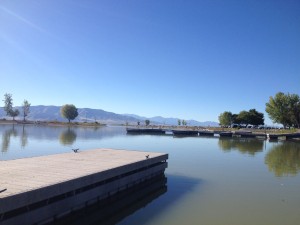
Utah County Health Department officials are warning people to not swim or boat in certain parts of Utah Lake. Dangerous toxins from blue-green algae, also known as pond scum, has collected in the area.
“Blue-green algae can grow quickly in what are called ‘blooms’ and can collect in slow-moving or stagnant water areas,” said Dr. Joseph Miner, Utah County Health Department (UCHD) director, in a news release.
The health department recently reported the death of a dog shortly after exposure to the toxins in the lake water. According to a news release, the dog started exhibiting symptoms, including vomiting and lethargy, about 45 minutes after playing in and possibly drinking the lake water. It passed away shortly after that.
Although the recent cyanobacteria bloom occurred in the Lindon Marina area, other blooms can and do occur in any area of the lake.
“Individuals should not swim or boat in areas of bright green water,” Carl Adams, Utah Department of Water Quality program manager, said in the press release. “The water is the color of car radiator antifreeze — it has a very distinctive color and should be avoided.”
According to Adams, the “pond scum” is not necessarily dangerous on its own. The toxic chemicals are only present when the algae cells are broken open. This can occur when the cells die off naturally and break open as they sink and decay in a lake. Cells may also break open when the water is treated with chemicals meant to kill algae, or when cells are swallowed and mixed with digestive acids in the stomachs of people or animals.
Unfortunately, the only way to be sure if the toxins are present in the water is to test samples in a laboratory with sophisticated equipment. But until such testing is completed, it is better to be on the safe side and avoid the algae until it clears up.
“Algae blooms can last for days or weeks, depending on weather conditions,” Adams said. “Calm, warm and sunny conditions promote blue-green algae growth, so it is possible the bloom will persist at least through the weekend, given the high pressure system currently over northern Utah.”
Symptoms of toxin exposure include stomach cramps, diarrhea, vomiting, headache, fever, muscle weakness and/or difficulty breathing. Authorities advise those who think they might have been exposed to contact their doctor. For more information, visit the Center for Disease Control website.




